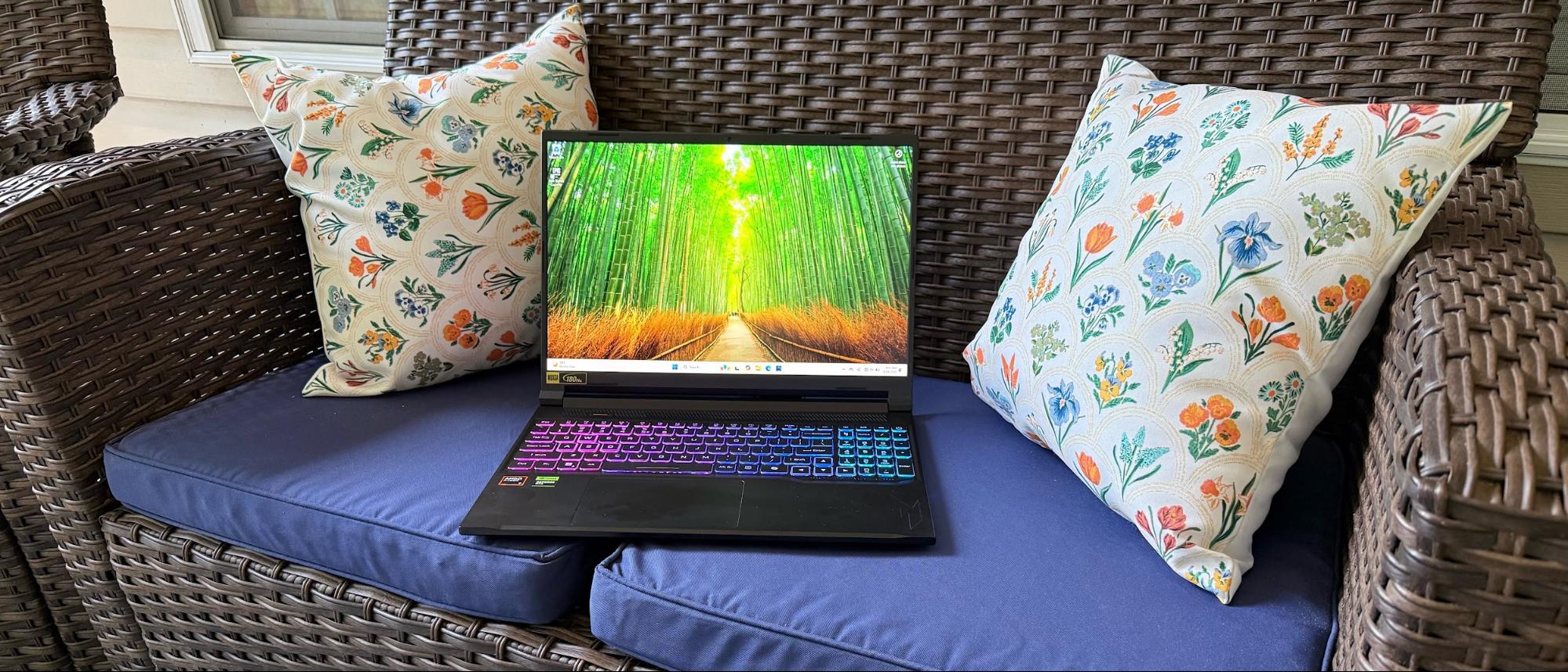Tom's Hardware Verdict
The Nitro V 16S AI offers plenty of superlatives for $1,299, but there are faster laptops at this price point.
Pros
- +
Reasonable price tag
- +
Variety of ports, including microSD
- +
Large, bright, and colorful display
- +
Fast storage performance
Cons
- -
Gaming performance at 1080p lags its price-competitive peers
- -
720p webcam is a disappointment
- -
Loads of bloatware
Why you can trust Tom's Hardware
Competition in the sub-$1,500 gaming laptop market is becoming intense, thanks to a steady influx of refreshed systems based on the latest Nvidia GeForce RTX 50-series GPUs. Acer is among the companies taking a swing at laptops in this segment — its entry at $1,299 is the Nitro V 16S AI.
That price gets you a stout system, as you’ll find an AMD Ryzen 7 260 processor, 32GB of RAM, a 1TB SSD, an RTX 5060 GPU, and a 180 Hz, 1200p, IPS display. If that wasn’t enough, Acer also throws in some other niceties like a four-zone RGB keyboard, a banging audio system, a plethora of ports, and surprisingly strong storage performance. As a gaming system, the 85-watt RTX 5060can’t hang with the RTX 5070 (or even RTX 4070) competition, but it still offers a lot of bang for the buck at this price.
Design of the Acer Nitro V 16S AI
The Nitro V 16S AI boasts an attractive design, featuring crisp lines and a restrained aesthetic. There's a Nitro logo on the lid, a relatively straightforward keyboard deck, and plenty of ventilation along the sides, rear, and bottom of the chassis. The only true tip-off to the gaming aspirations of the laptop is the four-zone RGB keyboard.
To give the Nitro V 16S AI a more upscale flair, the lid and bottom panel are aluminum. It's a small touch, but it helps differentiate the laptop from competitors in this class that use plastic across the board to meet a lower price target.
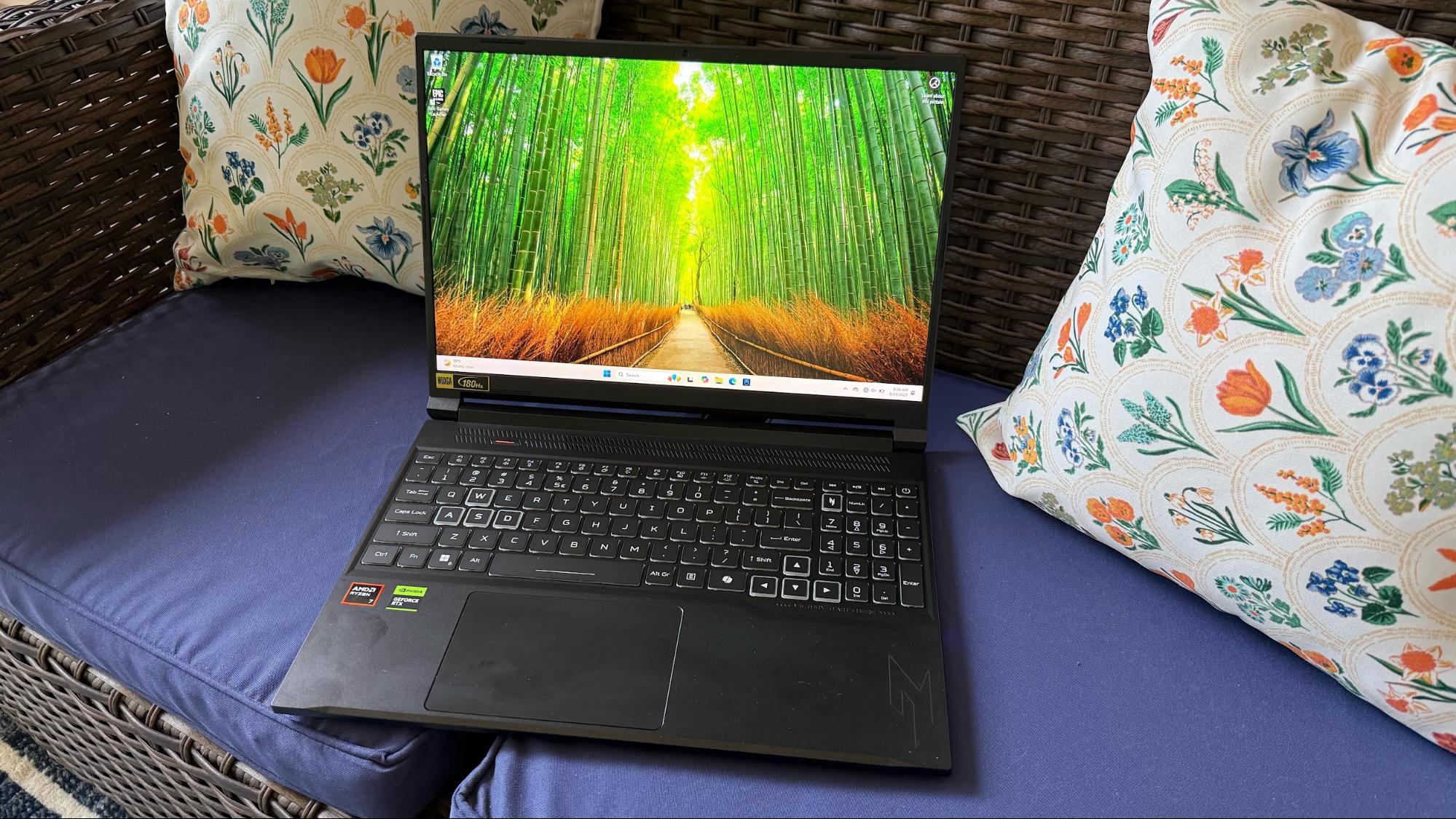
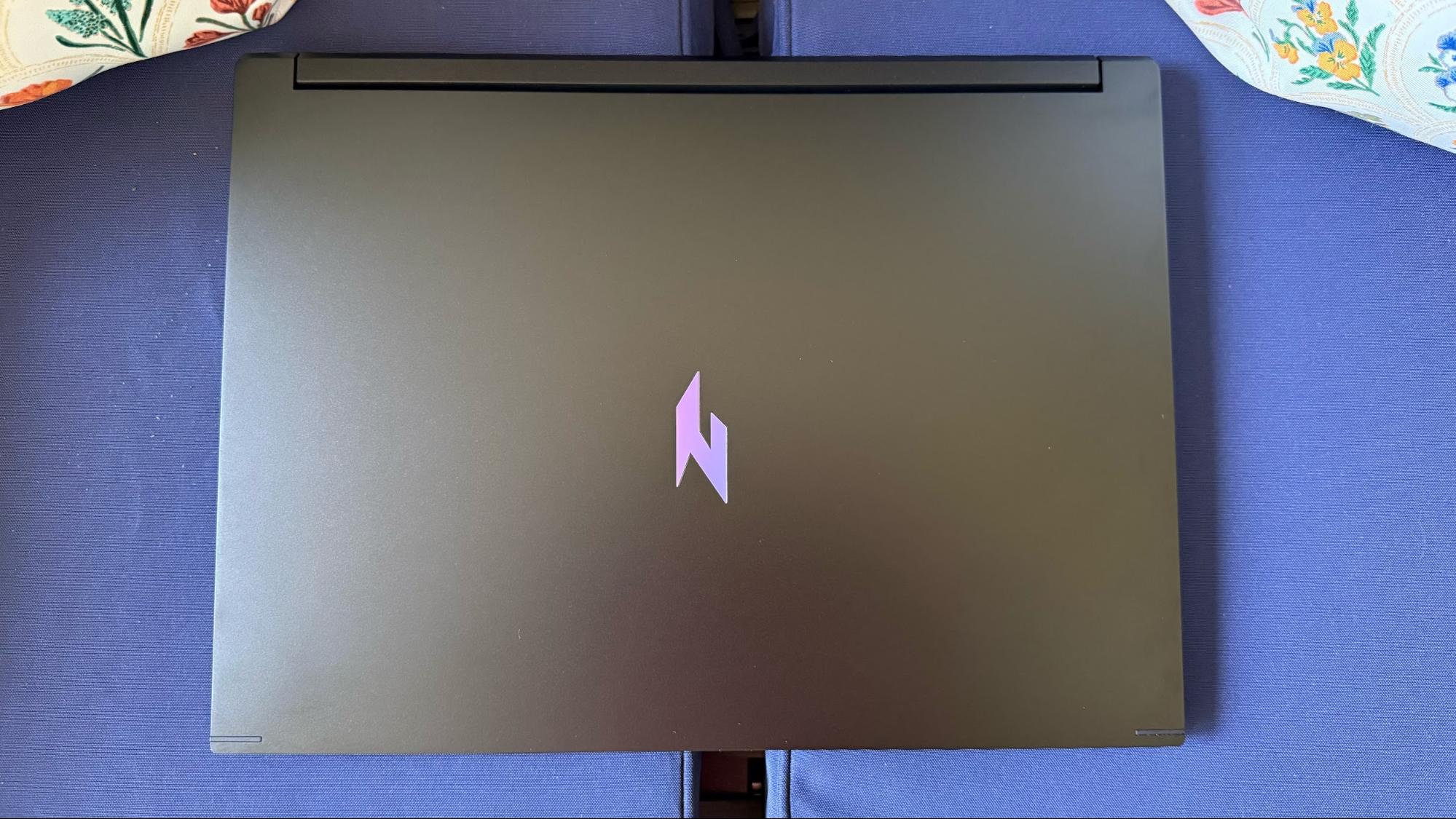
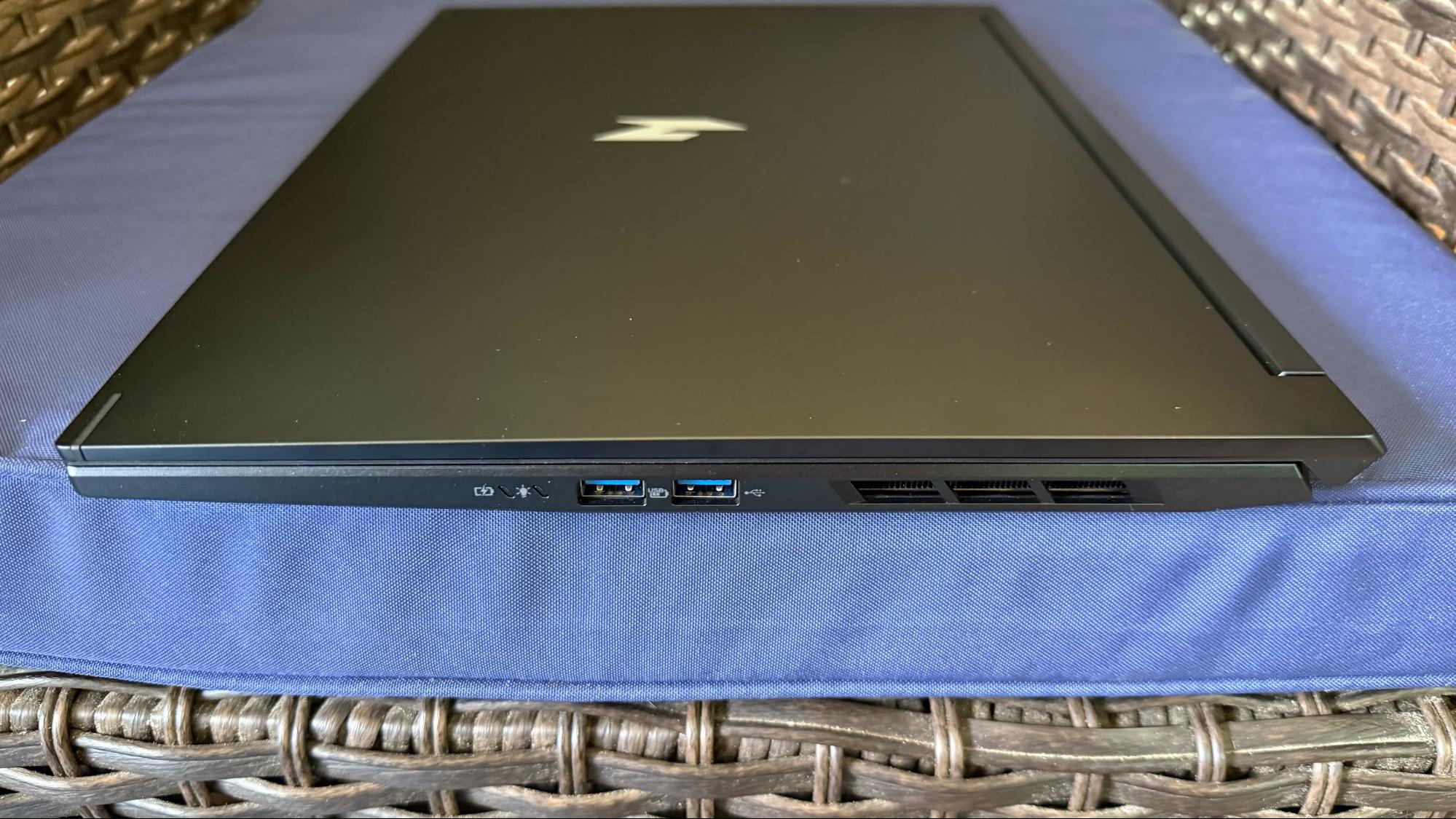
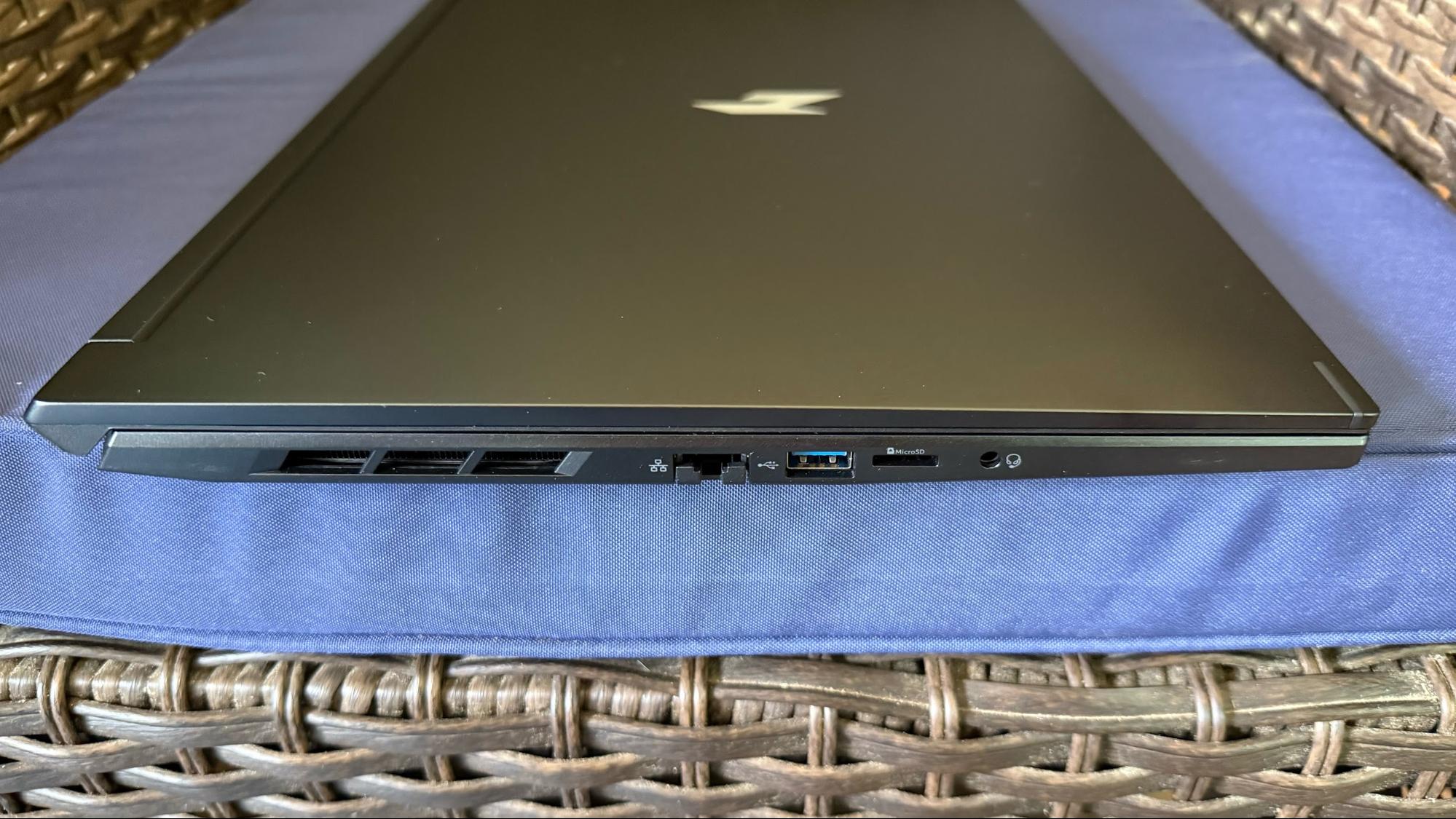
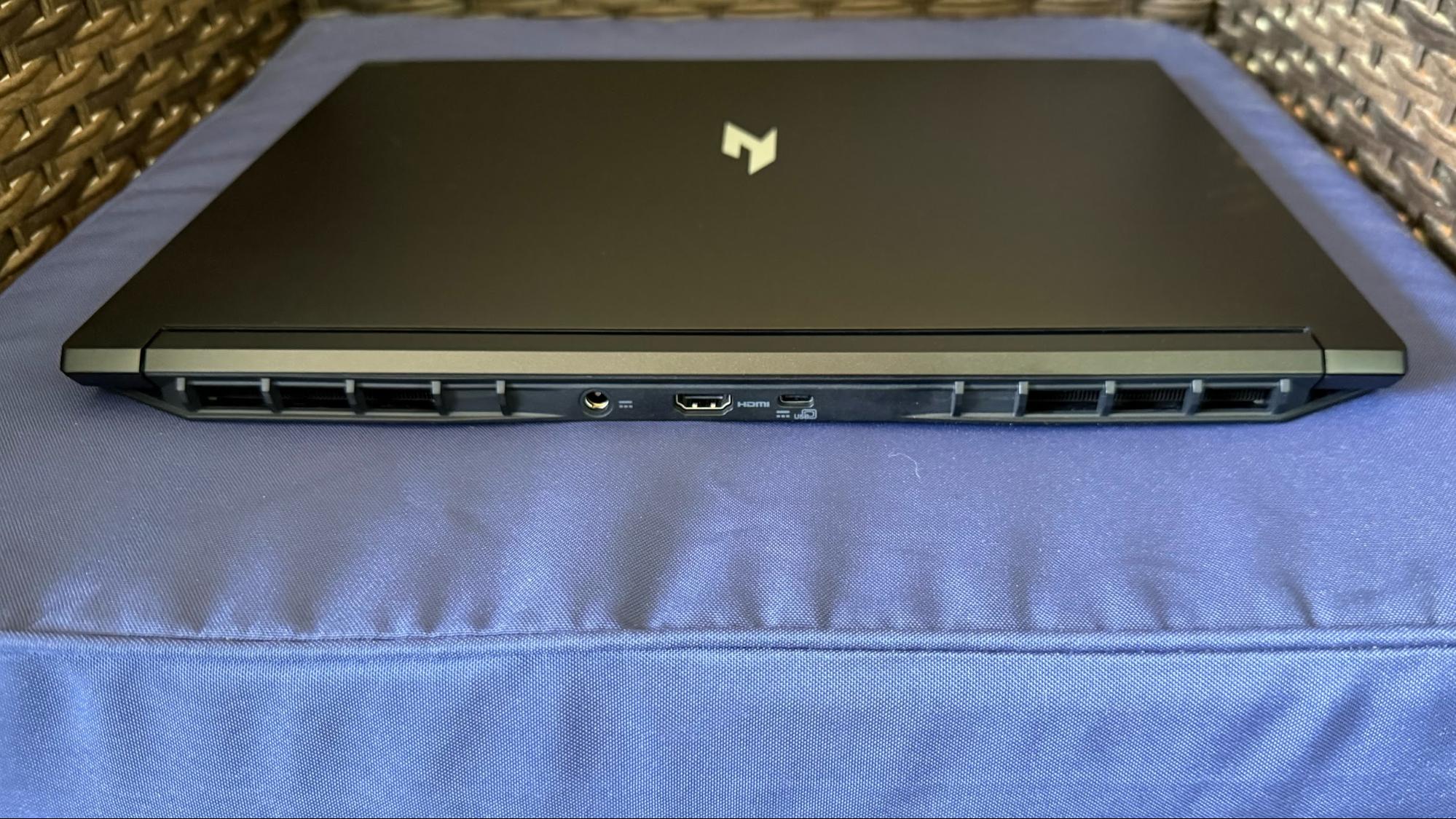
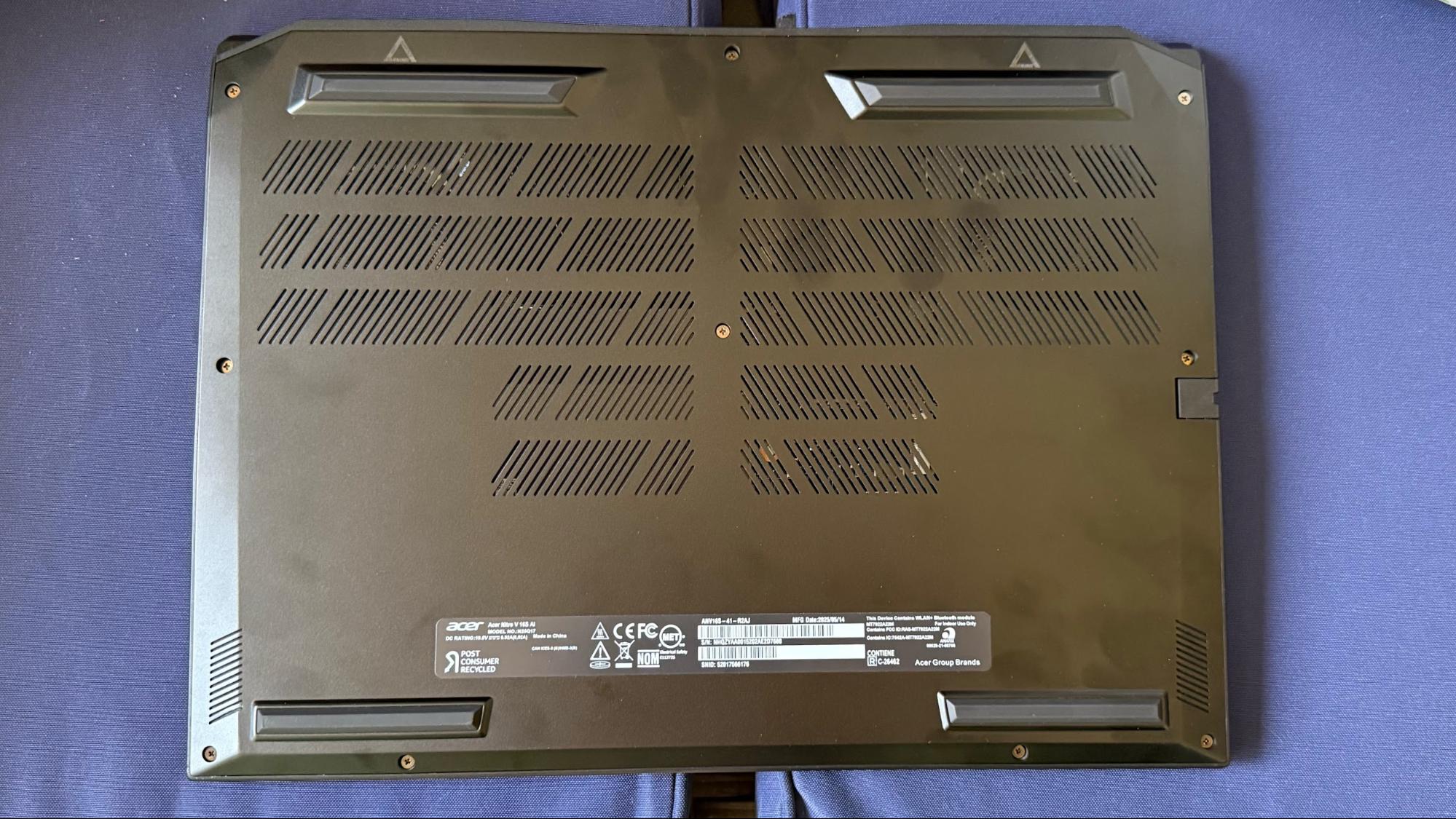
On the right side of the chassis, you'll find two USB Type-A ports. The left side brings another USB-A port, a Gigabit Ethernet port, a 3.5 mm headphone jack, and a rarity in this class: a microSD card slot. But that's not all, the back panel has even more ports, including a proprietary port for a barrel-style plug (a 135-watt power adapter is supplied), an HDMI 2.1 port, and a single USB-C port. Overall, the system should offer enough connectivity for the average person.
4.555.5 pounds. For comparison, the Alienware 16 Aurora measures 14.05 x 10.45 x 0.89 inches and weighs 5.64 pounds, while the Gigabyte Aorus 16X is 5.07 pounds with measurements of 14.02 x 10 x 1.06 inches. Rounding out the group is the MSI Katana 17 HX at 15.66 x 10.85 x 1.09 inches and weighing 5.95 pounds.
Acer Nitro V 16S AI Specifications
CPU | AMD Ryzen 7 260 |
Graphics | Nvidia GeForce RTX 5060 Laptop GPU (8GB GDDR7, 1,785 MHz max boost clock, 85W max graphics power) |
Memory | 32GB DDR5-5600 (2x 16GB) |
Storage | 1TB PCIe 4.0 NVMe SSD |
Display | 16-inch, 1920 x 1200, IPS, 16:10, 180 Hz |
Wireless Networking | RZ616 Wi-Fi 6E, Bluetooth 5.3 |
Ports | 1x USB 3.2 Gen 2 Type-C, 3x USB 3.2 Gen 2 Type-A, HDMI 2.1, 3.5 mm audio jack, Gigabit Ethernet |
Camera | 720p |
Battery | 76 WHr |
Power Adapter | 135 W |
Operating System | Windows 11 Home |
Dimensions (WxDxH) | 14.09 x 10.5 x 0.9 – 1.0 inches |
Weight | 4.55 pounds |
Price (as configured) | $1,299.99 |
Our Nitro V 16S AI review unit came configured with an AMD Ryzen 7 260 processor paired with 32GB of DDR5-5600 memory (2 x 16GB). The Ryzen 7 260 is a Zen 4-based “Hawk Point” processor with 8 CPU cores capable of executing 16 threads. The chip has a base clock of 3.8 GHz and can boost up to 5.1 GHz. There’s also a GeForce RTX 5060 GPU onboard, which in this configuration has a maximum boost clock of 1,785 MHz and a maximum TGP of 85 watts.
Get Tom's Hardware's best news and in-depth reviews, straight to your inbox.
Our system also features a 16-inch display with a 1920 x 1200 resolution that can run at up to 180 Hz.
When testing new gaming laptops, I like to break out Indiana Jones and the Great Circle to get a feel for how the system will perform. At 1200p resolution with the Ultra preset, I averaged around 90 frames per second (FPS), depending on the level of on-screen action. Dropping the resolution to 1080p only saw a slight performance improvement, averaging roughly 95 FPS.
| Header Cell - Column 0 | Price (as-tested) | CPU | GPU | Display | Memory | Storage | Battery | Weight | Ethernet | Wireless |
|---|---|---|---|---|---|---|---|---|---|---|
Acer Nitro V 16S AI | $1,299 | AMD Ryzen 7 260 | GeForce RTX 5060 | 16-inch, 1920 x 1200 | 32GB DDR5-5600 | 1TB | 76 WHr | 4.55 lbs | 1 GbE | Wi-Fi 6E |
$1,499 | Intel Core i7-240H | GeForce RTX 5060 | 16-inch, 2560 x 1600, 120 Hz | 32GB DDR5-5600 | 1TB | 96 WHr | 5.64 lbs | 1 GbE | Wi-Fi 7 | |
$1,599 | Intel Core i7-14650HX | GeForce RTX 4070 | 16-inch, 2560 x 1600, 165 Hz | 32GB DDR5-5600 | 1TB SSD | 99 WHr | 5.07 lbs | 1 GbE | Wi-Fi 7 | |
$1,299 | Intel Core i7 14650HX | GeForce RTX 5070 | 17.3-inch, 1920 x 1080, 144 Hz | 16GB DDR5-5600 | 1TB SSD | 75 WHr | 5.95 lbs | 1 GbE | Wi-Fi 6E |
We start our gaming benchmark suite with Shadow of the Tomb Raider (Highest settings), where the Nitro V 16S AI delivered 98 FPS at 1080p and 91 FPS at 1200p. This performance put it in last place, just behind the 16 Aurora (99 FPS at 1080p) with its 80-watt RTX 5060. The MSI Katana 17 HX delivered the highest performance at 1080p (119 FPS).
Moving to the very demanding Cyberpunk 2077 (Medium settings), our review unit hit 32 FPS at 1080p and 27 FPS at 1200p. This was enough for third place, putting behind the 16 Aurora and Katana 17 HX, which each reached 39 FPS at 1080p.
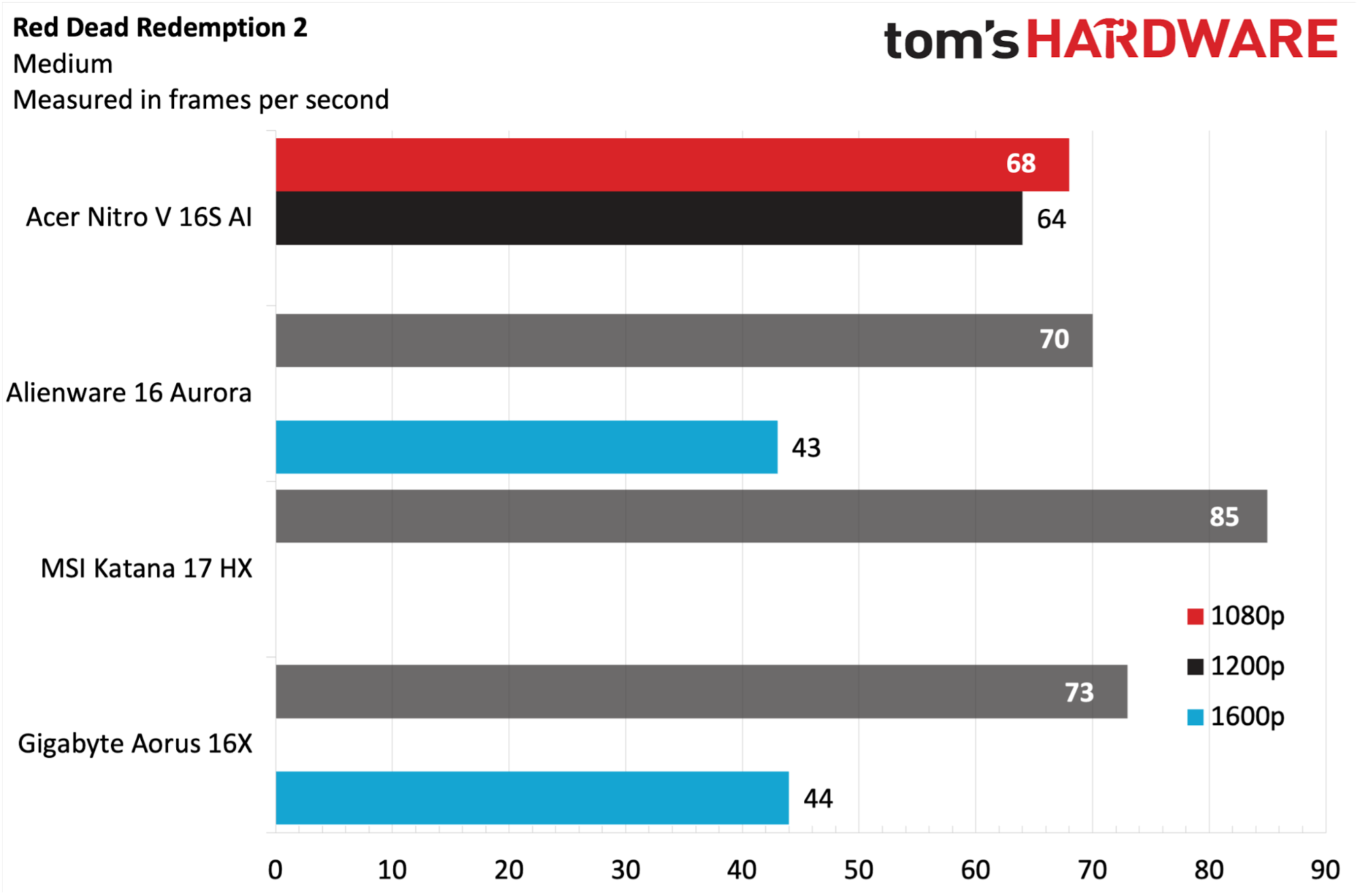
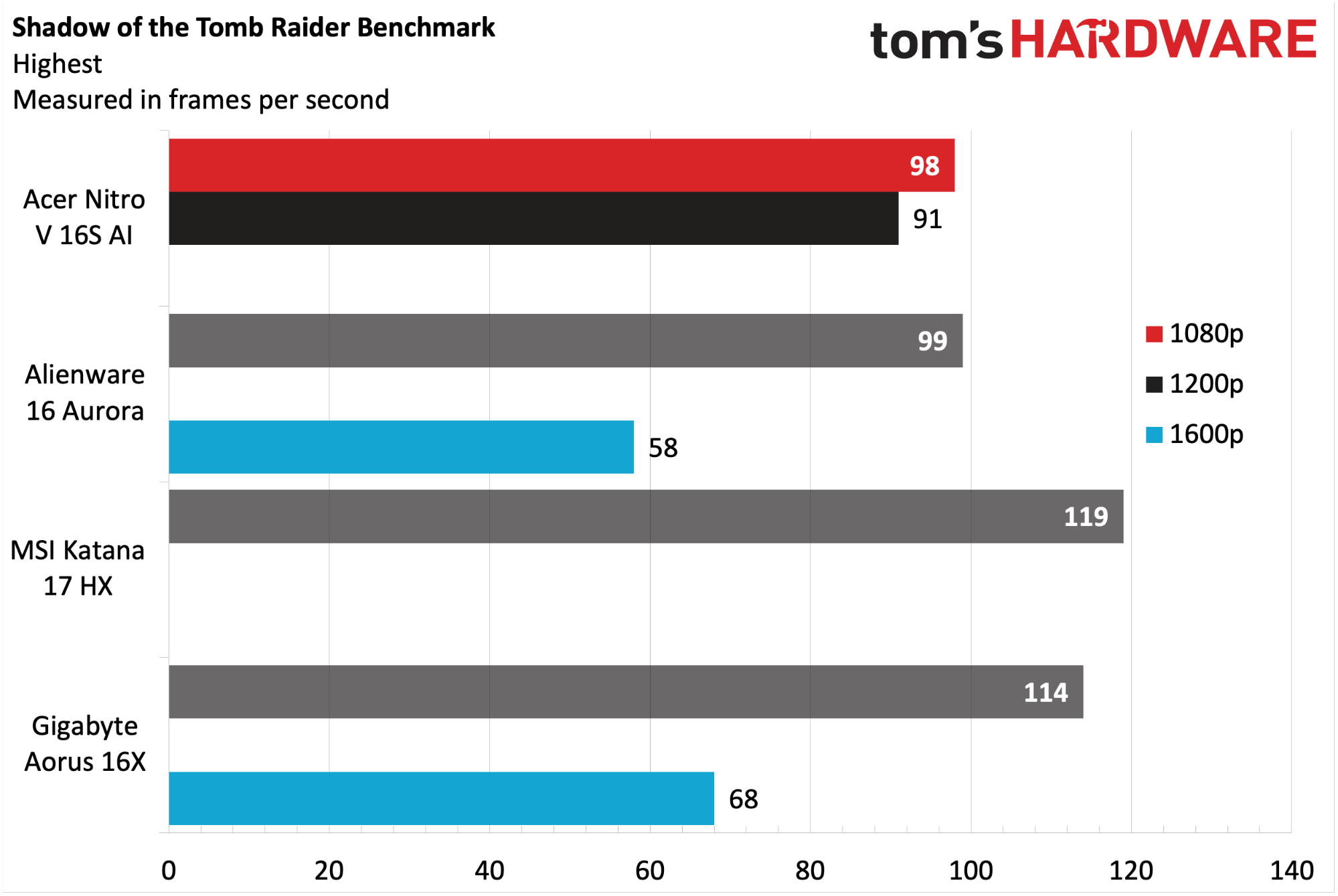

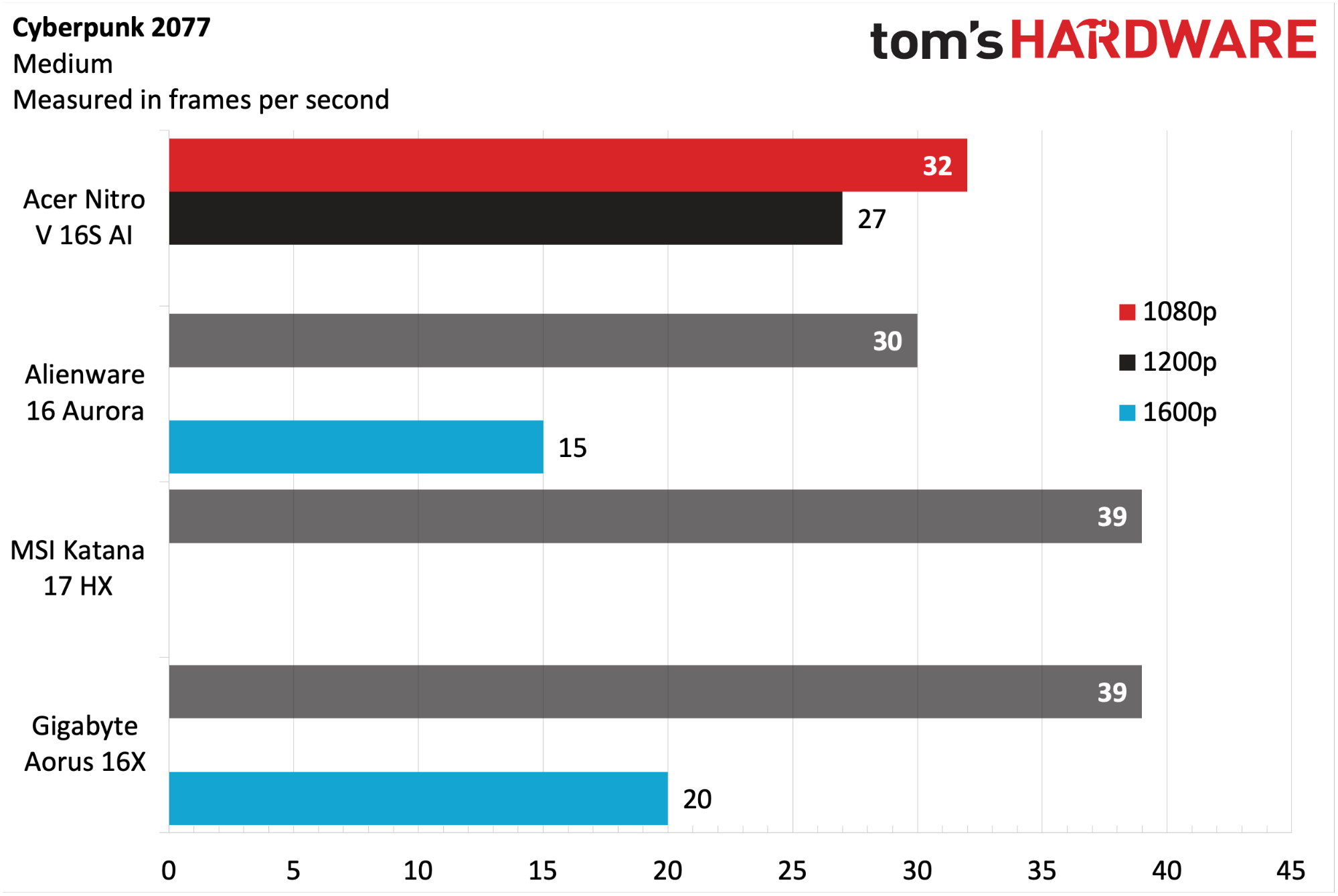
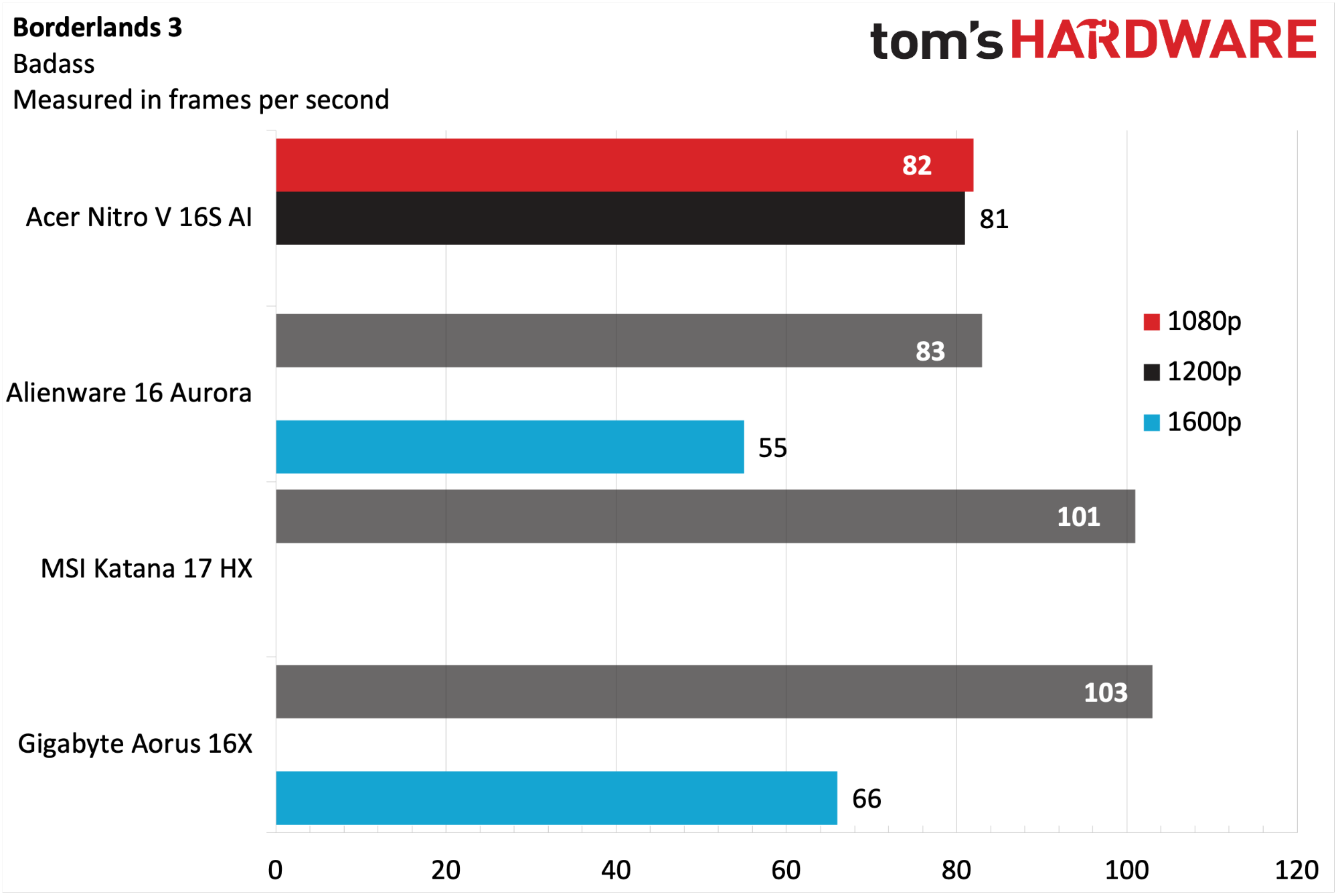
Far Cry 6 (Ultra settings) also saw the Nitro V 16S AI hanging back near the rear of the pack with 82 FPS at 1080p (79 FPS at 1200p). While this performance edged out the 16 Aurora (81 FPS at 1080p), it was well behind the top-performing Aorus 16X (103 FPS).
Red Dead Redemption 2 (Medium settings) is another graphically intense game, and the Nitro V 16S AI came in last place at 69 FPS when running at 1080p resolution. The Aorus 16X managed 73 FPS, while the Katana 17 HX led all contestants with 85 FPS at 1080p.
Finally, Borderlands 3 (Badass settings) also saw the Nitro V 16S AI in last place, hitting 82 FPS. The 16 Aurora was just 1 FPS faster, while the Katana 17 HX and Aorus 16X both broke 100 FPS.
Metro Exodus is our go-to benchmark for gaming laptop stress testing. We averaged 76.01 FPS at 1600p across 15 loops using the RTX benchmark preset. The CPU cores averaged 3.71 GHz.
Productivity Performance on the Acer Nitro V 16S AI
As previously mentioned, our review unit uses an 8-core AMD Ryzen 7 260 "Hawk Point" processor. Our configuration pairs that processor with 32GB of DDR5-5600 and a 1TB SSD (WD SN5000S).
Geekbench 6, the synthetic CPU benchmark, wasn't a strong point for the Nitro V 16S AI. Our review unit brought up the rear of the pack, with a single-core score of 2,659 and a multi-core score of 12,837. While the single-core performance was comparable to the other laptops, its multi-core performance lagged by 700 to nearly 2,000 points. The top performer in the test, the Aorus 16X, features 16 physical cores (8 performance, 8 efficiency).
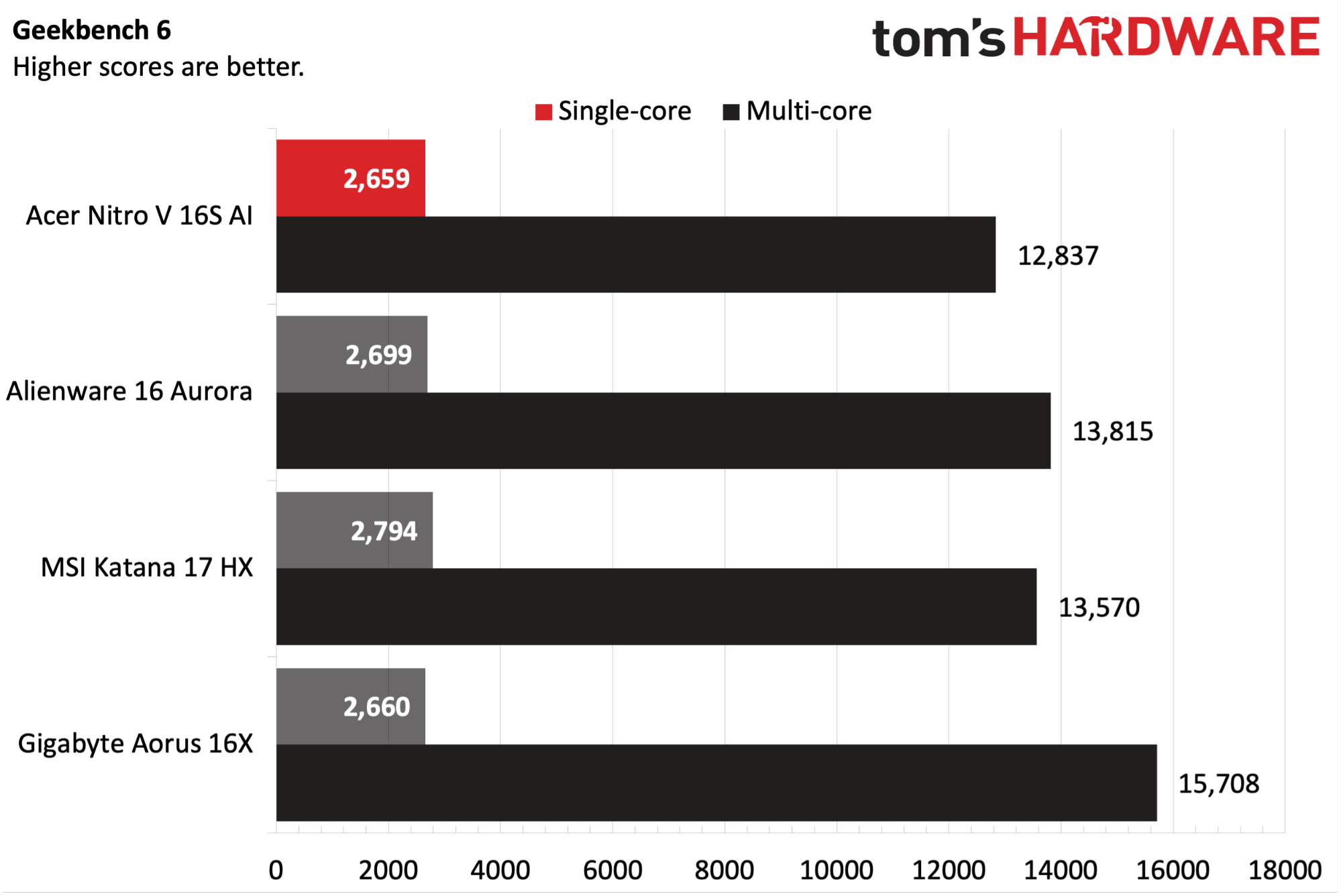

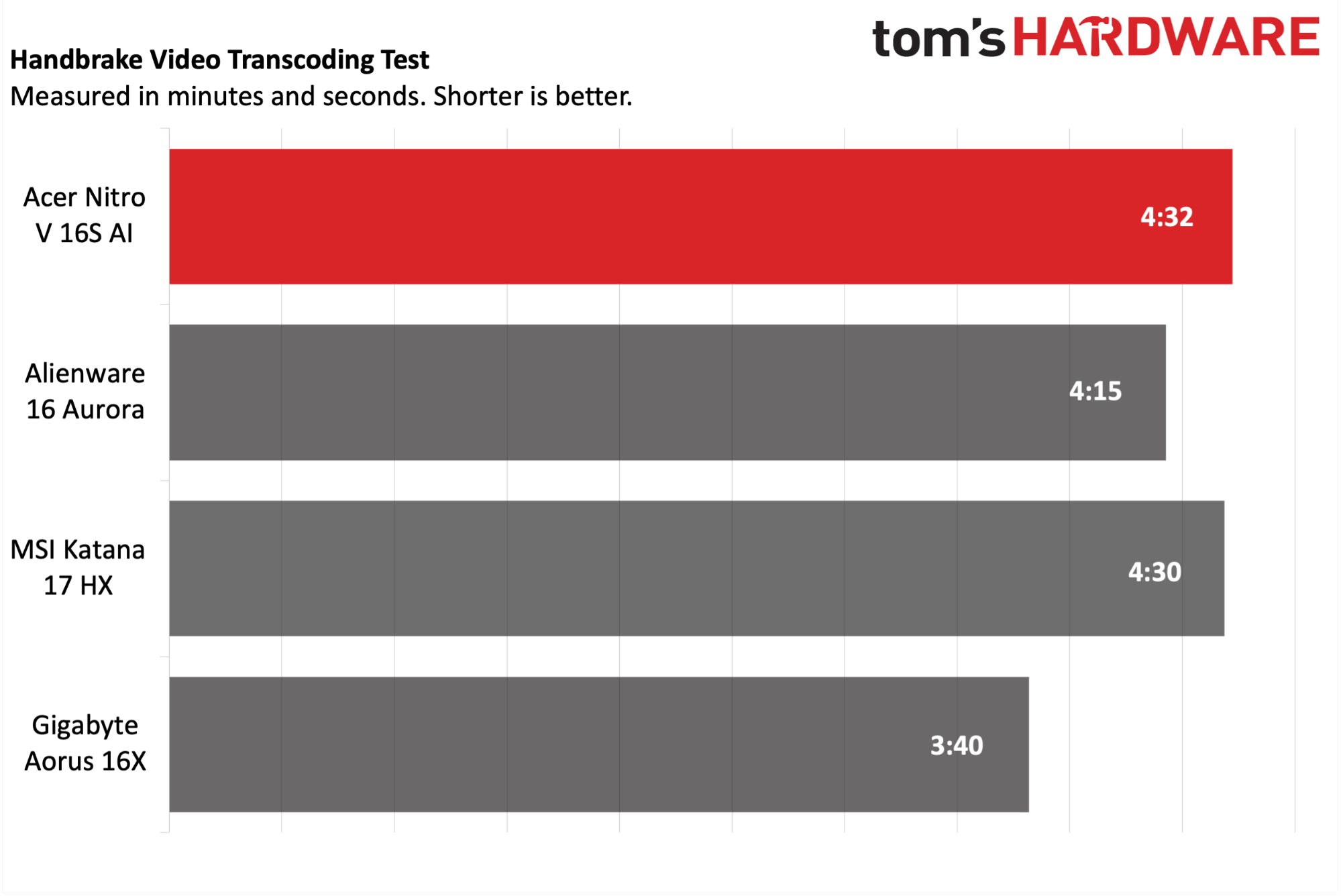
However, the Nitro V 16S AI turned things around in our storage benchmark, where we copied 25GB of mixed-media files. Here, our review unit torched all the competitors running at 1,838.88 MBps. The next-closest system was the Aorus 16X at 1,500.98 MBps. The Katana 17 HX (1,224.05 MBps) and 16 Aurora (1,179.12 MBps) were well behind.
The Ryzen 7 260 again showed some softness in its number crunching capabilities (at least in this crowd), finishing our 4K to 1080p Handbrake transcoding test in 4 minutes and 32 seconds. This performance put it in last place by 2 seconds behind the Katana 17 HX. The Aorus 16X was well out in front, completing the task in 3 minutes and 40 seconds.
Display on the Acer Nitro V 16S AI
The Nitro V 16S AI uses a 16-inch IPS display with a 1920 x 1200 resolution and a relatively speedy 180 Hz refresh rate. The panel has a matte finish, which helps reduce, but not completely eliminate, glare that can appear on the display.
The 1200p maximum resolution is just a slight step up from the 1080p on the Katana 17 HX, but well behind the 16 Aurora and Aorus 16X, which both feature 1600p displays. However, we have to remember that those two displays feature lower 120 Hz and 144 Hz refresh rates, respectively.
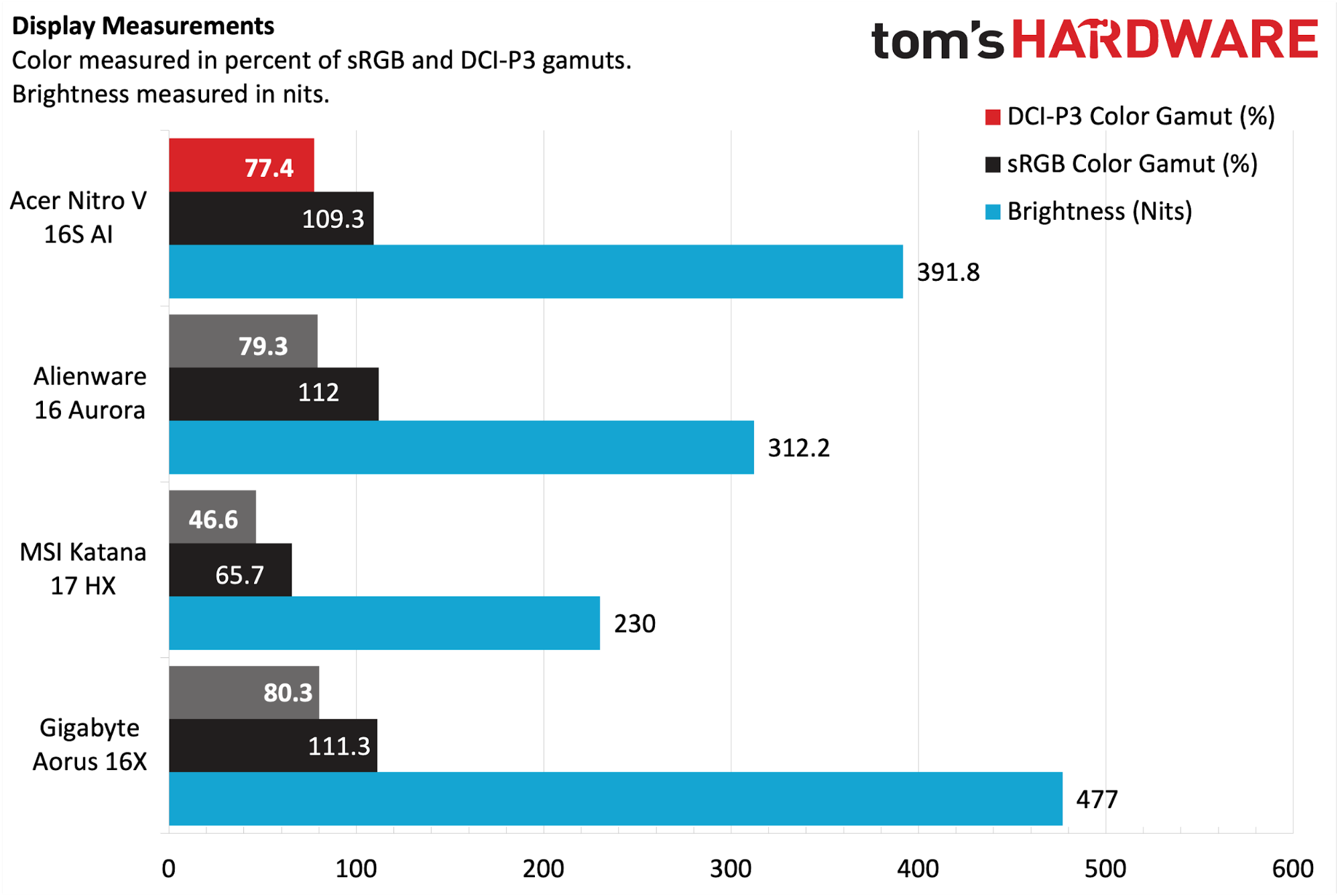
I found the display to be bright in my testing and didn’t notice any backlight bleeding across the entirety of the panel, which is a good thing. In our instrumented tests, the actual maximum brightness was measured at 391.8 nits, putting it in second place behind the Aorus 16X (477 nits). For me, text on the screen (i.e., Word and Excel documents) and games were adequately bright under varied lighting conditions indoors.
If we're going strictly by the numbers, the Nitro V 16S AI came in third place behind the Aorus 16X and 16 Aurora. It registered 77.4 percent coverage of DCI-P3 and 109.3 percent of sRGB. You probably wouldn’t choose this panel for color-critical work, but it’s a fair compromise for its primary mission: gaming.
Every game that I tried on the display looked great, including Cyberpunk 2077, Marvel’s Avengers, and Indiana Jones and the Great Circle. I spent the majority of my time playing the latter and was enthralled by the visuals in the Shanghai and Vatican missions.
Keyboard and Touchpad on the Acer Nitro V 16S AI
The 16-inch chassis of the Nitro V 16S AI allows for a large keyboard and an accompanying number pad. While you won’t find per-key RGB lighting, the keyboard is split into four user-configurable zones. There’s nothing remarkable about the keyboard, although you’ll notice that the WASD keys have a clear border around the keycaps and there’s a dedicated button on the number pad that opens the NitroSense utility.
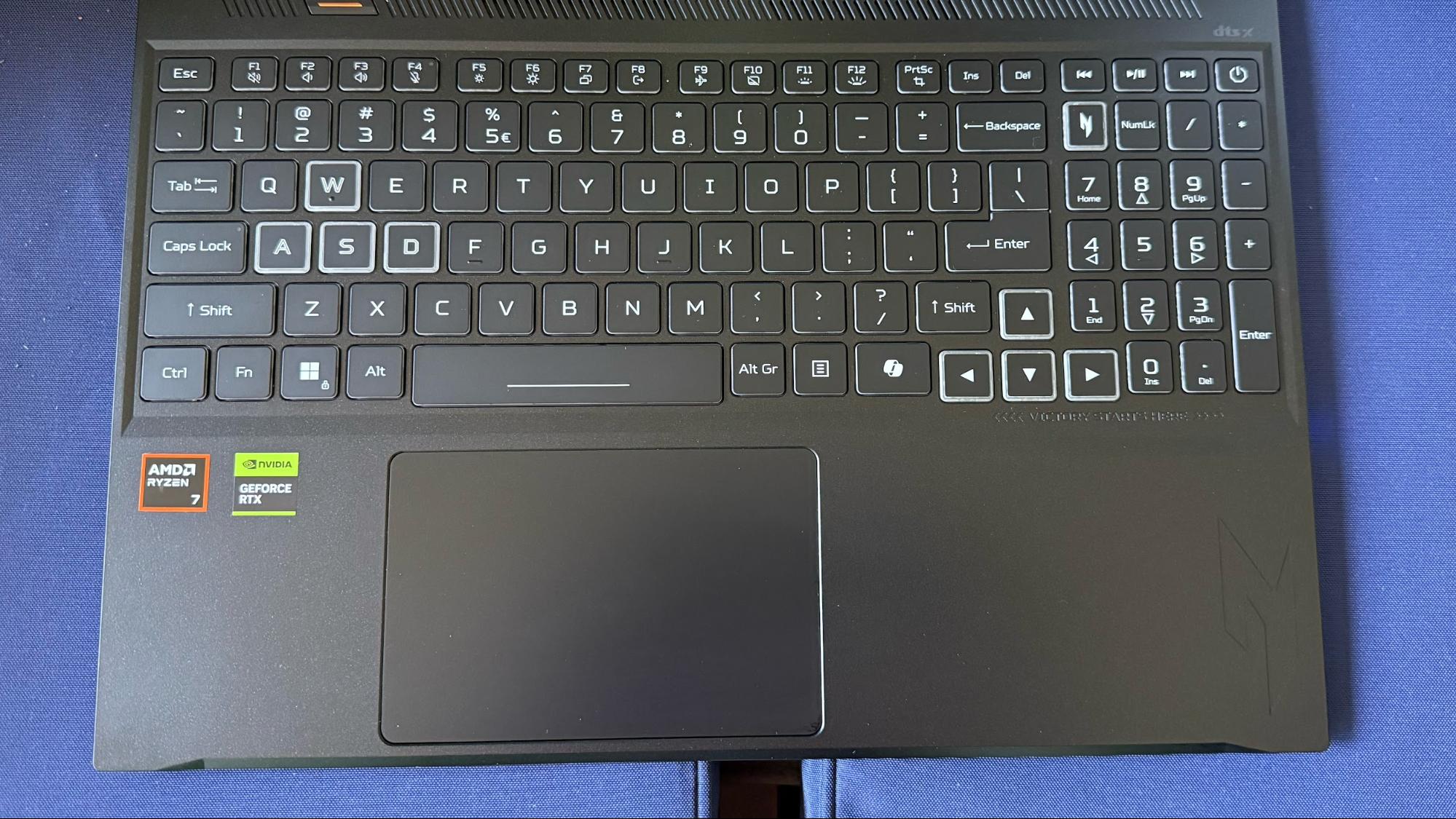
Using the online keyhero.com typing speed test, I averaged around 90 words per minute with 95 percent accuracy across three tests. That’s on the higher side for me, and is a testament to how comfortable my fingers felt dancing around the keyboard. As I’ve mentioned, I’m by no means a maniacally-fast typist, but the 90 WPM result surprised even me.
The Windows Precision Touchpad measures roughly 5 x 3.5 inches and offers a smooth gliding surface for navigation in Windows 11. Clicks are satisfying, and I was able to register a click over the majority of the touchpad, save for the top quarter of an inch of its surface (where it’s hinged).
Audio on the Acer Nitro V 16S AI
The Nitro V 16S AI is equipped with two speakers, which are located near the front of the chassis where your palms naturally lie. Given the value-laden roots of the Nitro V 16S AI, I wasn’t expecting much from the small speakers, but I was reasonably impressed with the volume output. With the volume cranked to 45 percent, the speakers were loud enough to fill my home office and were already overwhelming my senses – I had no desire to go any higher.
I played “Today” by Zero 7 and was amazed at how clear and vibrant Jose Gonzalez’s vocals were on the track. Bass was a little lacking, but the instrumentals were on point. For a nostalgia kick, I also played “Off the Wall” from Michael Jackson’s 1970s disco-infused solo album. The album showcased Jackson’s maturity as an adult singer and laid the groundwork for a masterpiece, "Thriller," which would be released three years later. I found myself bouncing around in my gaming chair as I marveled in not only Michael’s vocals, but the haunting background vocals that pop in and out during the track.
Bass was not a high point, and it never usually is with laptops, particularly in the mainstream segment. But the overall audio quality was stellar.
If you want to tweak the audio system further, you can do so with the included DTS:X Ultra app.
Games also sounded great with the onboard speakers, with Cyberpunk 2077 and Indiana Jones and the Great Circle. Everything from gunfire to vehicle sounds, to in-game dialogue was crisp and clear. However, for the best audio experience, I’d suggest checking out the best gaming headsets.
Upgradeability on the Acer Nitro V 16S AI
The bottom aluminum panel is affixed using 10 Phillips head screws. Then a few well-placed fingernails allowed me to pry the panel off and reveal the inside of the chassis. You’ll notice the black monolith that is the 76 WHr battery at the bottom of the chassis, flanked by the stereo speakers.

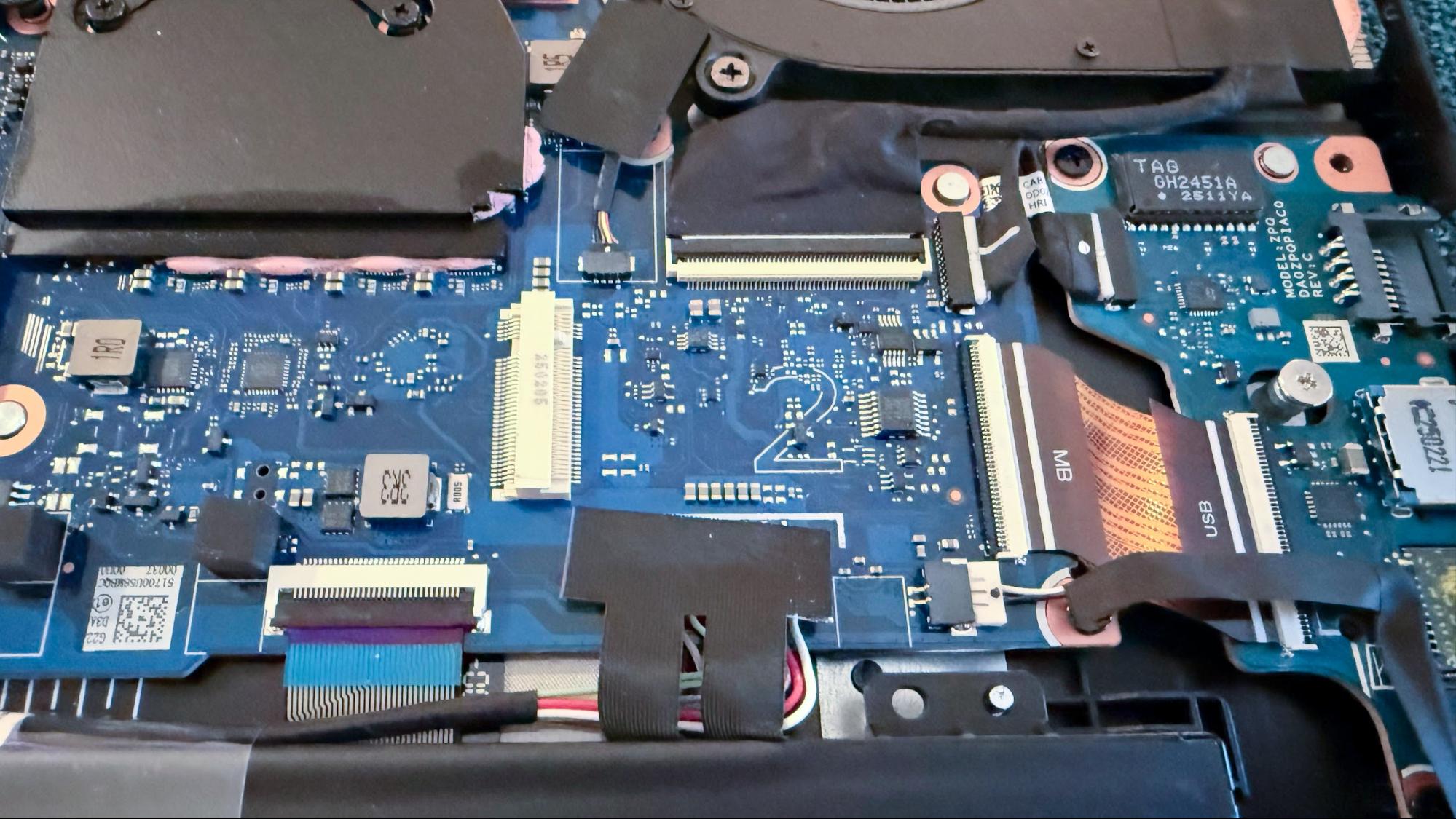
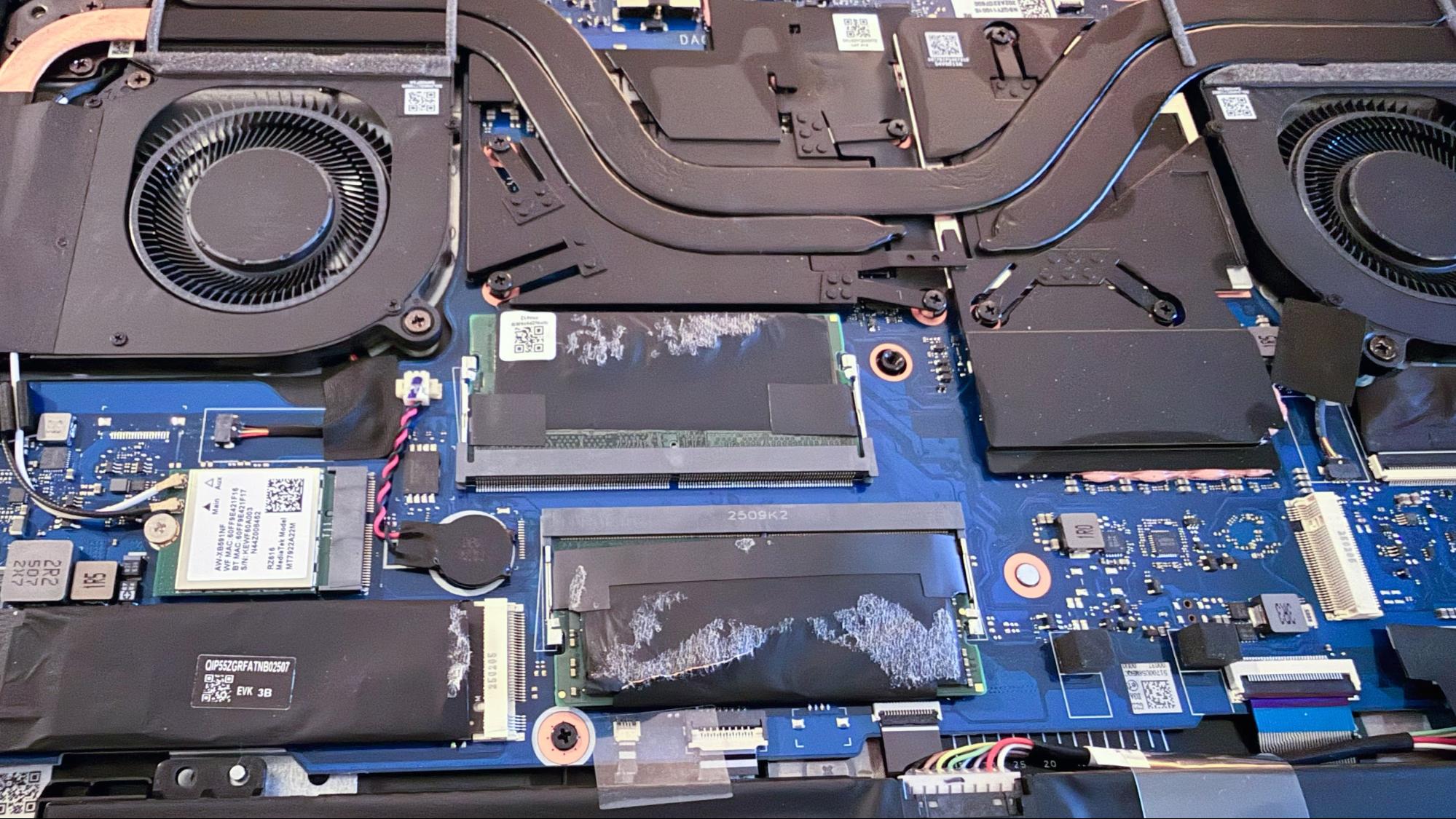

Directly above are two M.2 slots (each accommodating up to 2280 SSDs). One of the slots is occupied (in our case, with a WD SN5000S SSD), while the other is empty for further expansion. Two SO-DIMM slots are located under a plastic thermal pad, with each occupied by a 16GB DDR5-5600 module. The only other user-replaceable item is the RZ616 Wi-Fi 6E M.2 PCIe module. If you want a performance upgrade, check out our handy guide on upgrading to Wi-Fi 7.
Battery Life on the Acer Nitro V 16S AI
AMD’s Hawk Point processors are built on a TSMC 4nm FinFET process node, and they tend to be quite efficient when it comes to power consumption. That was definitely the case with our Nitro V 16S AI review unit, which is powered by a 76 WHr battery.
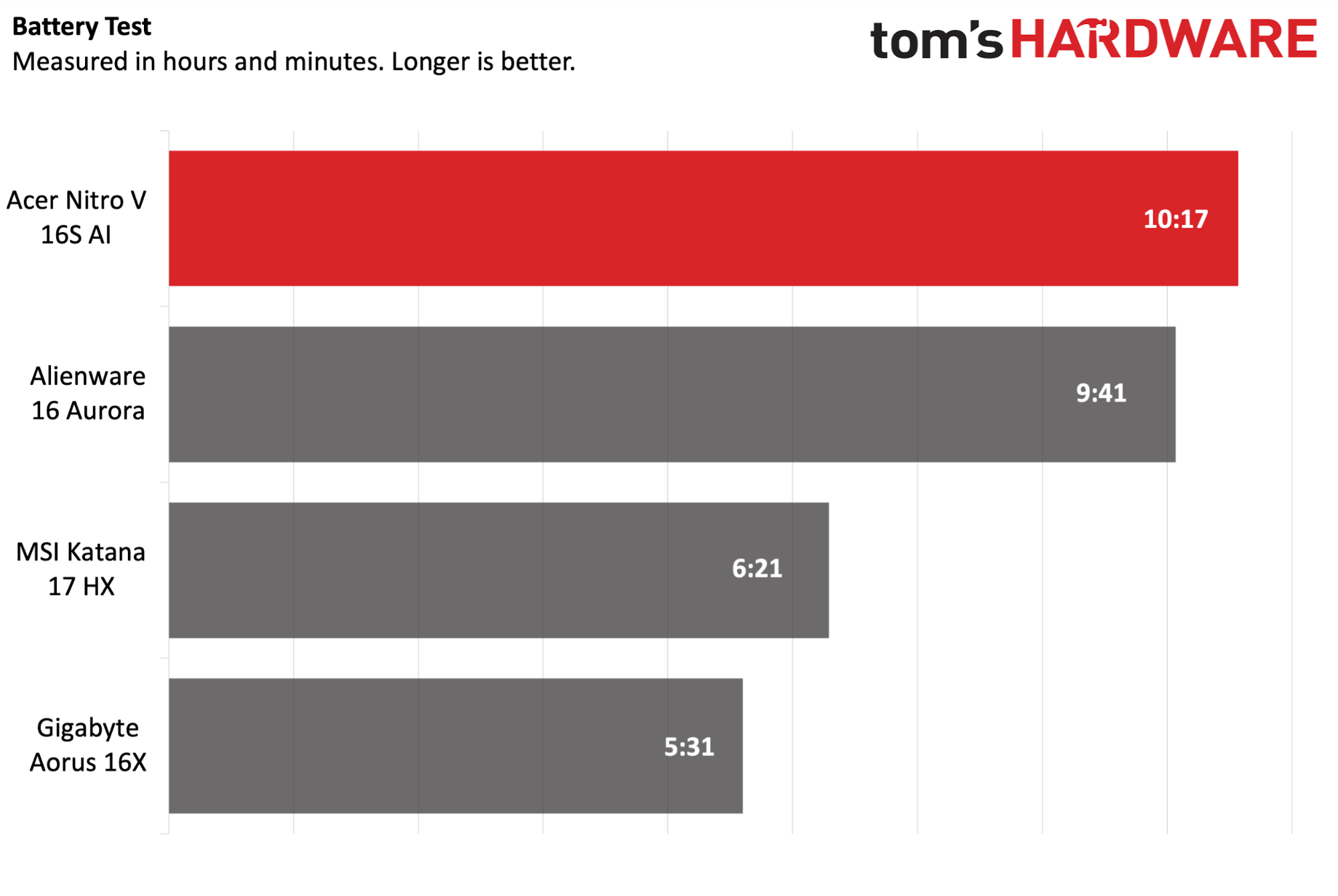
The laptop was an excellent performer on our battery test (for a gaming rig, anyway), which consists of web browsing, video streaming over Wi-Fi, and conducting OpenGL tests with the screen brightness set at 150 nits. The Nitro V 16S AI lasted over 10 hours and 17 minutes, which was an impressive showing in this assembly of laptops.
The next closest competitor was the 16 Aurora (9:41), followed by the Katana 17 HX (6:21).
Heat on the Acer Nitro V 16S AI
The Nitro V 16S AI uses a twin-fan cooling system that draws air from the bottom of the laptop and through the keyboard and expels it out the vents on the sides and back. Although the fans ramp up the RPMs relatively quickly under load, the sound output is not objectionable. Even during the 15-run Metro Exodus stress test, the noise levels were low.
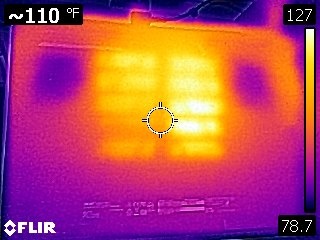
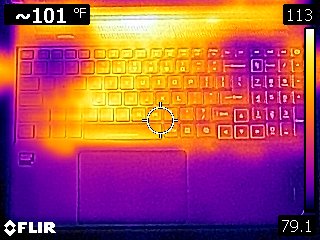
With that said, we measured 79 degrees Fahrenheit (F) at the touchpad and 109 F between the G and H keys. The underside of the chassis was much warmer at 110 F. However, the hottest part of the chassis was at the bottom of the case, right of center, which measured 127 F.
During the Metro Exodus stress test, the CPU package measured 60 degrees Celsius (C). Meanwhile, the RTX 5060 ran at an average of 1.92 GHz at 66.5 C.
Webcam on the Acer Nitro V 16S AI
We were on an upward swing regarding moving swiftly from 720p webcams to 1080p, especially during and past lockdowns. However, we’ve seen manufacturers of newer entry-level and mainstream gaming laptops again opting for 720p webcams. Unfortunately, Acer is among them with the Nitro V 16S AI.
Overall image quality is grainy, with poor color reproduction. My facial hair appeared as a blurry mess of black on the screen. Since I’ve been spoiled by the 1080p webcams on most new laptops, taking a serious step backwards to 720p was a stark contrast. Additionally, the Nitro V 16S AI doesn’t include an IR camera, so you can’t take advantage of facial recognition for signing into Windows 11 via Windows Hello. (With no fingerprint reader, that means there are no biometric options at all.)
Software and Warranty on the Acer Nitro V 16S AI
With most laptops available today, you’ll find at least a handful of apps that the manufacturer installs from the factory. In the case of the Nitro V 16S AI, there were over a dozen apps/shortcuts occupying space in the Start Menu. There were four Acer-specific apps, including Acer LiveArt (an AI-powered image editing tool), Acer Purified Voice Console (which uses AI to reduce background noise during calls), Acer QuickPanel (for webcam and mic controls), and NitroSense (an all-in-one utility for managing system performance, keyboard lighting, updates, etc.).
Other preinstalled software/shortcuts include App Explorer, Elvenar (a free city-building game), Express VPN, Forge of Empires, Google Play Games Beta, DTS:X Ultra, Killer Intelligence Center (for the Killer Ethernet E2600 network adapter), and Planet9. If this were my laptop, the majority of these apps would be junked upon the first boot.
The Nitro V 16S AI ships with a one-year limited warranty from Acer.
Acer Nitro V 16S AI Configurations
Currently, Acer is only offering one configuration of the Nitro V 16S AI (ANV16S-41-R2AJ), which is the same as our review unit. The system features an AMD Ryzen 7 260 processor, 32GB DDR5-5600, a 1TB SSD, GeForce RTX 5060 GPU, 16-inch 180Hz 1200p IPS display, Wi-Fi 6E, 1 GbE, and Windows 11 Home. The system carries an MSRP of $1,299, but isn't yet available for purchase either at Acer's online store or from Amazon (although the product page is active).
Bottom Line
The Acer Nitro V 16S AI is a well-made machine with plenty to brag about.. The laptop is well constructed, it's relatively lightweight in this class, the display is vibrant and bright, and you get a large assortment of ports (including a microSD slot). At $1,299, the price is also attractive, undercutting the similarly-performing Alienware 16 Aurora by $200.
If all you care about is outright performance, for the same $1,299, the MSI Katana 17 HX runs the tables against the Nitro V 16S with its more powerful RTX 5070 GPU. However, the Nitro V 16S is by far a more complete package when considering the display, audio system, and overall build quality.

Brandon Hill is a senior editor at Tom's Hardware. He has written about PC and Mac tech since the late 1990s with bylines at AnandTech, DailyTech, and Hot Hardware. When he is not consuming copious amounts of tech news, he can be found enjoying the NC mountains or the beach with his wife and two sons.
-
Pemalite The RTX 5060 only having 8GB of VRAM is probably the biggest disappointment... I'll probably hang onto my older RTX 3060 notebook for another year because of it....Reply
